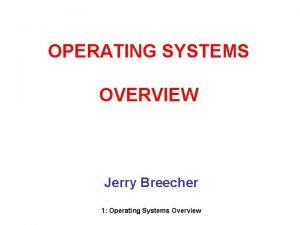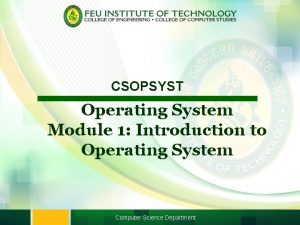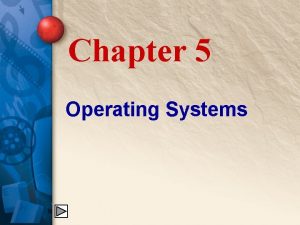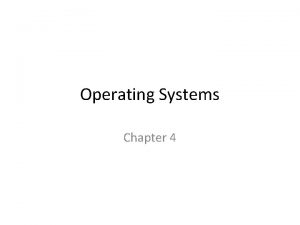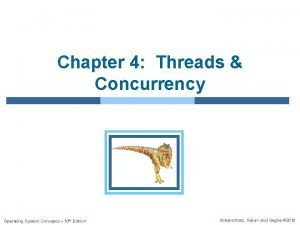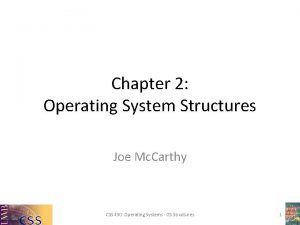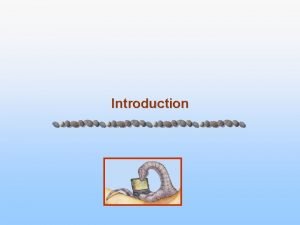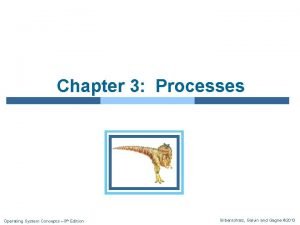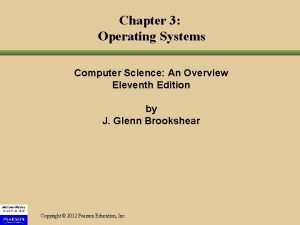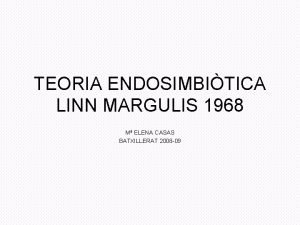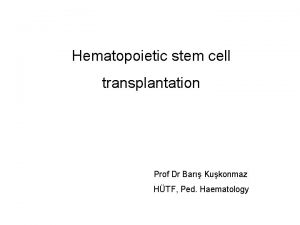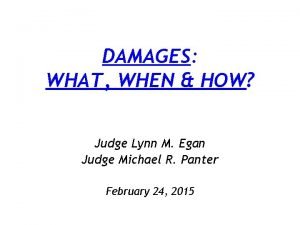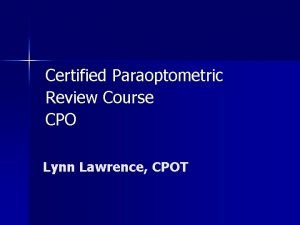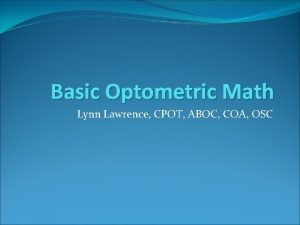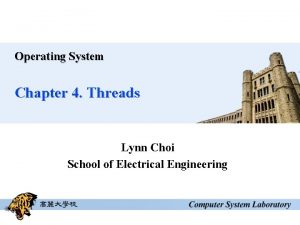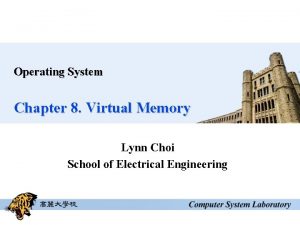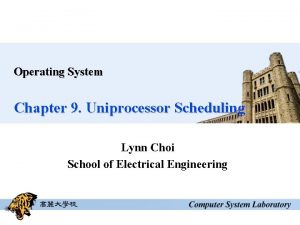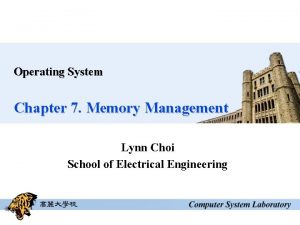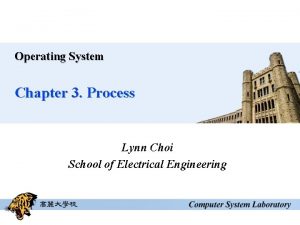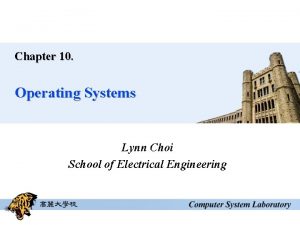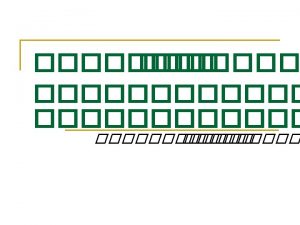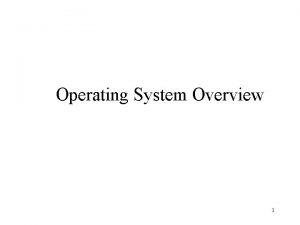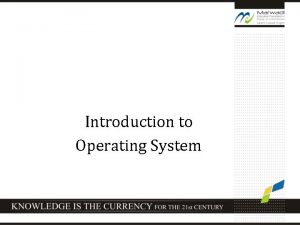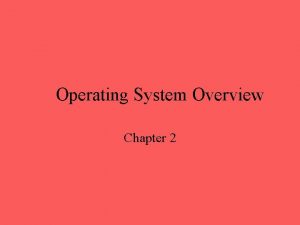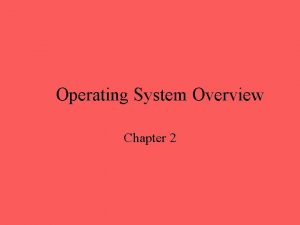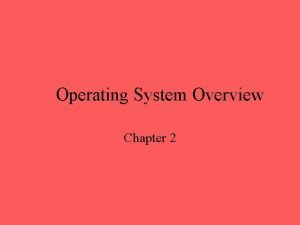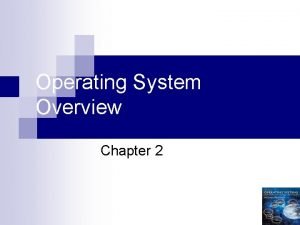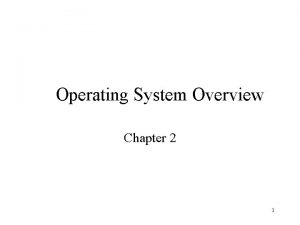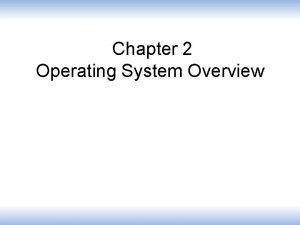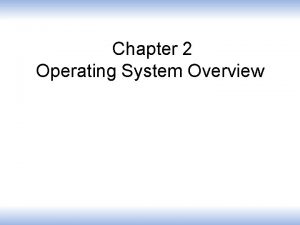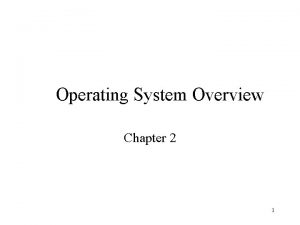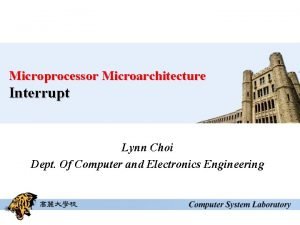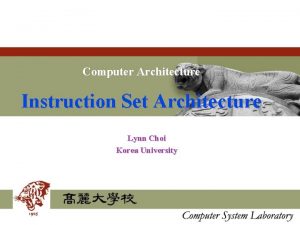Operating System Chapter 2 OS Overview Lynn Choi






























- Slides: 30

Operating System Chapter 2. OS Overview Lynn Choi School of Electrical Engineering

Class Information q Lecturer Prof. Lynn Choi, School of Electrical Eng. Phone: 3290 -3249, 공학관 411, lchoi@korea. ac. kr, TA: 배한준, 3290 -3896, qwerty 2901@korea. ac. kr q Time Mon/Wed 2 pm – 3: 15 am Office Hour: Wed 4: 00 pm – 5: 00 pm q Place 창의관 207 q Textbook “Operating Systems: Internals and Design Principles”, William Stallings, Pearson, 8 th Edition, 2015. q References “Operating System Concepts”, Silberschatz, Galvin, and Gagne, Wiley, 9 th Edition, 2012. “Computer Systems: A Programmer’s Perspective”, Randal E. Bryant and David O’Hallaron, Prentice Hall, 2 nd Edition, 2011. q Class homepage http: //it. korea. ac. kr : slides, announcements

Class Information q Course overview 1. OS Overview 2. Process 3. Thread 4. Mutual Exclusion and Synchronization 5. Deadlock and Starvation 6. Memory Management 7. Virtual Memory 8. Uniprocessor Scheduling 9. Multiprocessor and Realtime Scheduling 10. IO 11. File Management 12. Virtual Machine

Class Information q Evaluation Midterm : 35% Final: 35% Homework and Projects: 30% Class participation: extra 5% - Attendance: no shows of more than 2 will get -5% - Bonus points

Abstract view of a computer system Operating system controls the hardware and coordinates its use among the various application programs for the various users

OS q Operating system A layer of software between the application program and the hardware Three purposes - Easy of use: Provide applications with simple and uniform interface to manipulate complicated and often widely different low-level hardware devices - Sharing: Share the hardware resource from multiple processes/users and increase the resource utilization - Protection: Protect the hardware from misuse by runaway applications Incorrect or malicious program should not cause other programs to execute incorrectly 6 Smartphone and PC operating systems emphasize easy of use while server and mainframe OSs emphasize sharing, protection, and fairness 6 Commercial operating systems usually provide not only kernels (programs running at all times on the computer) but also system middleware, system programs, and application programs. Use abstractions such as processes, virtual memory, and files

OS Application programs Software Operating system Processor Main memory I/O devices Layered view of a computer system Processes Virtual memory Files Processor Main memory I/O devices Abstractions provided by an OS Hardware

Operating System q An OS is a program that provides convenient services for application programs by managing hardware resources and acts as an interface between applications and the computer hardware Source: Pearson

Key Interfaces q Instruction set architecture (ISA) Define the interface between SW and HW - A set of machine language instructions - Both application programs and utilities can access the ISA directly q Application binary interface (ABI) Define the system call interface to OS q Application programming interface (API) Define the program call interface to system services. System calls are performed through library calls. - Enables application programs to be ported easily, through recompilation, to other systems that support the same API

Terminology q Microprocessor: a single chip processor - Intel i 7, Pentium IV, AMD Ryzen, SPARC T 5, . . q ISA (Instruction Set Architecture) Defines machine instructions and visible machine states (registers + memory) Examples - IA 32(x 86), IA 64, ARM, MIPS, SPARC, Power. PC 6 x 86 family: Intel Pentium, Pentium Pro, Pentium 4, AMD Athlon 6 x 86 -64 family, Intel i 3, i 5, i 7, i 9 6 IA 64 family: Itanium, Itanium 2, Itanium 9300/9500/9700 6 ARM family: ARM 7, ARM 11, ARM Cortex-A 53 q Microarchitecture Implementation: HW design and implementation according to the ISA - Pipelining, caches, branch prediction, buffers - 80386, 80486, Pentium Pro, Pentium 4 are the 1 st, 2 nd, 3 rd, 4 th, 5 th implementation (microarchitecture) of x 86 ISA Invisible to programmers - From the programmer’s perspective, both 80486 and Pentium 4 support the same ISA and show the same behavior for a machine instruction

Terminology q CISC (Complex Instruction Set Computer) Each instruction is complex - Instructions of different sizes, many instruction formats, allow computations on memory data, … A large number of instructions in ISA Architectures until mid 80’s - Examples: x 86, VAX q RISC (Reduced Instruction Set Computer) Each instruction is simple - Fixed size instructions, only a few instruction formats A small number of instructions in ISA Load-store architectures - Computations are allowed only on registers 6 Data must be transferred to registers before computation Most architectures built since 80’s - Examples: MIPS, ARM, Power. PC, Alpha, SPARC, IA 64, PA-RISC, etc.

Terminology q Word Default data size for computation - Size of a GPR & ALU data path depends on the word size 6 GPR stands for general purpose (integer) registers 6 ALU stands for arithmetic and logic unit The word size determines if a processor is a 8 b, 16 b, 32 b, or 64 b processor q Address (or pointer) Points to a location in memory Each address points to a byte (byte addressable) - If you have a 32 b address, you can address 232 bytes = 4 GB - If you have a 256 MB memory, you need at least 28 bit address since 228 = 256 MB q Caches Faster but smaller memory close to processor - Fast since they are built using SRAMs - Smaller since they are expensive - Usually inside CPU chip (located between processor core and main memory)

Evolution of Operating Systems Multiprogrammed Batch Systems Serial Processing Time Sharing Systems Simple Batch Systems Source: Stallings Lecture Slide

Serial Processing q Earliest computers No operating system until mid 1950 s - Programmers interacted directly with the computer hardware Computers ran from a console with display lights, toggle switches, some form of input device, and a printer q Problems Scheduling - Most installations used a hardcopy sign-up sheet to reserve computer time. However, time allocations could run short or long, resulting in wasted time Setup time - A considerable amount of time was spent just on setting up the program to run. Compile/link/load require mounting tapes, setting up card decks, etc. Early computers were very expensive - Important to maximize processor utilization

Alan Turing, Bombe and Colossus Bletchley Park Source: Wikipedia

Alan Turing (1912 ~ 1954) q Turing Machine (1936) A new mathematical computing model A symbol manipulating device that can simulate the logic of any computer - Consists of infinite linear tape, read/write head, and control unit Theoretical background to modern computers q Bombe (1940) A electromechanical machine to decipher German’s Enigma q Turing Test (1950) A computer could be said to "think" if a human interrogator could not tell it apart, through conversation, from a human being q ACM Turing Award – the Novel prize in Computer Science

Colossus q Colossus (1943) The 1 st programmable digital (electronic) computer built by Thomas Flowers in London

ENIAC q ENIAC (Electronic Numerical Integrator And Computer) Designed by John Mauchly and John Presper Eckert at University of Pennsylvania Funded by US BRL (Ballistic Research Lab) to develop range and trajectory tables for new weapons - Until then, BRL employee more than 200 people with desktop calculators to solve the necessary ballistics equations - The proposal accepted in 1943, the machine completed in 1946, and dismantled in 1955 Used for H-bomb research Characteristics - 30 tons, 15000 square feet, 18000 vacuum tubes, 140 KW power dissipation - Decimal machine 20 accumulators each holding 10 -digit decimal number 6 Each digit is represented by a ring of 10 vacuum tubes 6 - Manually programmed by setting switches and plugging/unplugging cables - 5, 000 additions per second

ENIAC Source: Wikipedia

The Von Neumann Machine & IAS Source: IAS

Simple Batch Systems q Monitor User submits the job on cards or tape to a computer operator, who batches them together sequentially and places them on an input device Monitor is a resident software in main memory Monitor reads in jobs one at a time from the input device. The current job is placed in the user program area The control is passed to the job. When the job is completed, it returns control to the monitor - User no longer has direct access to the processor q History The first batch OS was developed by GM in the mid-1950 s for use on IBM 701 By the early 1960 s, a number of vendors developed batch OS for their computer systems Source: Pearson

Batch Systems: Problems q Processor is often idle Even with automatic job sequencing I/O devices are slow compared to processor Source: Pearson

Multiprogrammed Batch System Source: Pearson q When one job needs to wait for I/O, the processor can switch to the other job, which is likely not waiting for I/O Also known as multitasking Memory can be expanded to hold three, four, or more programs

Multiprogramming Example Source: Pearson

Utilization Histogram Source: Pearson

Effects on Resource Utilization Table 2. 2 Effects of Multiprogramming on Resource Utilization Source: Pearson

Time-Sharing Systems q Can be used to handle multiple interactive jobs In a time-sharing system, several users share a computer system through terminals at the same time. In this system, minimizing response time is more important than maximizing throughput (processor utilization) OS interleaves the execution of each user program in time slice. - Context switching occurs every time slice. The currently running job is suspended and a previously suspended job (or a new job) is resumed (is selected for execution). Short jobs or I/O intensive jobs do not have to wait for long computeintensive jobs

Compatible Time-Sharing Systems q CTSS: One of the first time-sharing OS Developed at MIT by a group known as Project MAC Ran on a computer with 32, 000 36 -bit words of main memory, with the resident monitor consuming 5000 words To simplify both the monitor and memory management a program was always loaded to start at the location of the 5000 th word - First developed for IBM 709 in 1961 and later transferred to IBM 7094 - Running on 7094, CTSS supported 32 users q Time Slicing System clock generates interrupts at a rate of approximately one every 0. 2 seconds At each interrupt OS regained control and could assign processor to another user Old user programs and data were written out to disk Old user program code and data were restored in main memory when that program was next given a turn

CTSS Operation Source: Pearson

Homework 1 q q q Read Chapter 1 Read Chapter 2 Exercise 2. 1 Exercise 2. 2 Exercise 2. 3 Read Chapter 3
 Operating systems overview
Operating systems overview Overview of operating systems
Overview of operating systems Financial intermediaries
Financial intermediaries Buddy system memory
Buddy system memory File system in operating system
File system in operating system Ufs4.0
Ufs4.0 File system in operating system
File system in operating system Type of network operating system
Type of network operating system Operating system chapter 1 notes
Operating system chapter 1 notes Chapter 4 operating system
Chapter 4 operating system Operating system concepts chapter 8 solutions
Operating system concepts chapter 8 solutions Operating system concepts chapter 5 solutions
Operating system concepts chapter 5 solutions Operating system concepts chapter 5 solutions
Operating system concepts chapter 5 solutions Concurrency vs parallelism in os
Concurrency vs parallelism in os Windows operating system architecture
Windows operating system architecture What operating system is this
What operating system is this Operating system chapter 3
Operating system chapter 3 Operating system chapter 3
Operating system chapter 3 Teoria autogena
Teoria autogena Christine e lynn
Christine e lynn Lynn brewer enron
Lynn brewer enron Galliano's pizza
Galliano's pizza Jerusalem lynn
Jerusalem lynn Doru pope seattle
Doru pope seattle Lynn white jr
Lynn white jr Lynn savoie
Lynn savoie Judge lynn egan
Judge lynn egan Certified paraoptometric practice test
Certified paraoptometric practice test Lynn cohn mediator
Lynn cohn mediator Transposing plus cylinder to minus
Transposing plus cylinder to minus Lynn university library hours
Lynn university library hours
